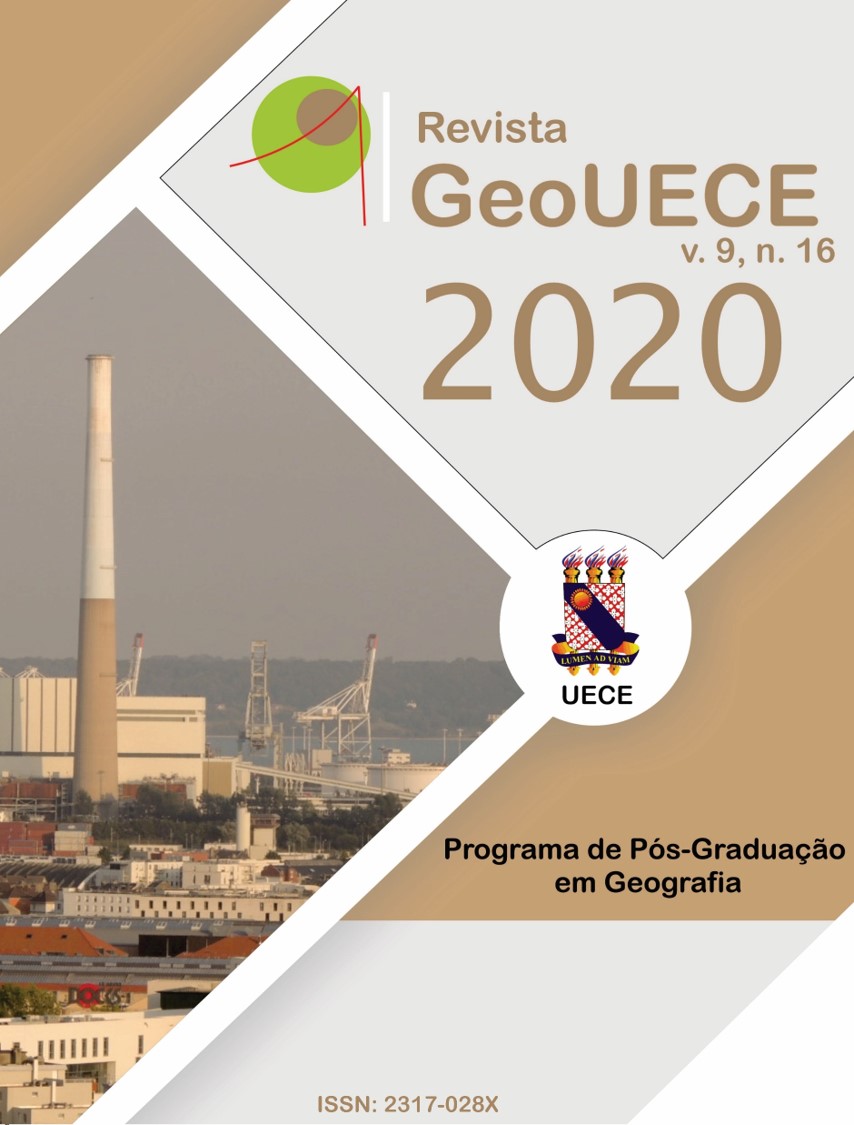RELACIÓN ENTRE LA PROPAGACIÓN DEL PROCESO INVASIVO DE GlEDITSIA TRIACANTHOS Y LA DEPOSICIÓN DE ARENA EN BOSQUES DEL RÍO URUGUAY
DOI:
https://doi.org/10.59040/GEOUECE.2317-028X.v9.n16.110-122Palavras-chave:
Ecosistema fluvial, análisis espacial, Gleditsia triacanthos, deposición de arenaResumo
Os ecossistemas fluviais apresentam alta vulnerabilidade. Sua degradação está fundamentalmente associada a alterações do regime hídrico que afetam a deposição e, consequentemente, as condições edáficas que determinam o estabelecimento da vegetação e podem afetar processos invasivos de espécies vegetais reconhecidas como outra ameaça importante. Portanto, é relevante entender a relação entre condições edáficas e processos invasivos. Este trabalho avalia a relação entre o conteúdo de areia e a distribuição do Gleditsia triacanthos lenhoso invasivo em uma floresta do rio Uruguai. Foram caracterizados o padrão espacial da variação na textura do solo, o padrão de distribuição de G.triacanthos e as relações entre ele e o teor de areia do solo. Variações na textura do solo foram detectadas no eixo norte-sul e no eixo leste-oeste. Foi detectada uma relação complexa entre a abundância de G.triacanthos e o teor de areia do solo.
Downloads
Métricas
Referências
ACHKAR, M., CANTÓN, V., CAYSSIALS, R., DOMINGUEZ, A., FERNÁNDEZ, G., PESCE, F. & SOSA, B. Las Áreas Protegidas en el Uruguay. El caso de los Bañados de Farrapos. Departamento de Río Negro, Uruguay. L, Ordinaire Mexique Amerique Central 191, 85–104. 2003.
BORNETTE, G., TABACCHI E, HUPP, C., S. PUIJALON, S. & ROSTAN, J. A model of plant strategies in fluvial hydrosystems. Freshwater Biology: 53, 1692–1705. 2008. https://doi.org/10.1111/j.1365-2427.2008.01994.x. DOI: https://doi.org/10.1111/j.1365-2427.2008.01994.x
BRUNSDON, CH., STEWART FOTHERINGHAM, A. & MARTIN E. CHARLTON
Geographically Weighted Regression: A Method for Exploring Spatial Nonstationarity Geographical Analysis Vol. 28, No. 4. 1996. https://doi.org/10.1111/j.1538-4632.1996.tb00936.x. DOI: https://doi.org/10.1111/j.1538-4632.1996.tb00936.x
CHANETON, E., MAZIA, C., MACHERA, M., UCHITEL, A., GHERSA, C. Establishment of Honey Locust (Gleditsia triacanthos) in Burned Pampean Grasslands. Weed Technology. 18, 1325–1329. 2004 https://doi.org/10.1614/0890-037X(2004)018[1325:EOHLGT]2.0.CO;2. DOI: https://doi.org/10.1614/0890-037X(2004)018[1325:EOHLGT]2.0.CO;2
CSURHES, S., KRITICOS, D. Gleditsia triacanthos L. (Caesalpiniaceae), another thorny, exotic fodder tree gone wild. Plant Protect. Quarter. 9 (3), 101–105. 1994.
GAZZANO, I. Viabilidad de la ganadería familiar en áreas protegidas de humedales, en un contexto sinérgico de intensificación agraria e inundaciones: Parque Nacional Esteros de Farrapos-Uruguay. Tesis Doctoral. Departamento de Ciencias Sociales y Humanidades. Instituto de Sociología y Estudios Campesinos. Universidad de Córdoba. España. 2014.
GRIME, J., JEFFREY, D. Seedling establishment in vertical gradients of sunlight. Journal of Ecology 53 (3), 621–642. 1965. https://www.jstor.org/stable/2257624 DOI: https://doi.org/10.2307/2257624
HENDERSON, L. Invasive, naturalized and casual alien plants in southern Africa: a sum – mary based on the Southern African Plant Invaders Atlas (SAPIA). Bothalia 37 (2), 215–248. 2007. https://doi.org/10.4102/abc.v37i2.322. DOI: https://doi.org/10.4102/abc.v37i2.322
HOOK, D. Waterlogging tolerance of lowland tree species of the south. South. Journal of Applied Forest. 8 (3), 136–149. 1984. DOI: https://doi.org/10.1093/sjaf/8.3.136
JASIEWICZ, J. & STEPINSKI, T. Geomorphons a pattern recognition approach to classification and mapping of landforms. Geomorphology 182, 147–156. 2013 https://doi.org/10.1016/j.geomorph.2012.11.005. DOI: https://doi.org/10.1016/j.geomorph.2012.11.005
LEE, J. & WONG, D. Statistical analysis with ArcView GIS. John Wiley & Sons, Inc., USA 192pps. 2001.
MARCO, D. & PÁEZ, S. Invasion of Gleditsia triacanthos in Lithraea ternifolia montane forests of central Argentina. Environmental Management. 26 (4), 409–419. 2000. DOI: https://doi.org/10.1007/s002670010098
MATTHEWS, S. & YANG, T. Mapping the results of local statistics: Using geographically weighted regression. Demographic Research. 26: 151–166. 2012
doi: 10.4054/DemRes.2012.26.6. DOI: https://doi.org/10.4054/DemRes.2012.26.6
NAIMAN, R. & DECAMPS, H. The Ecology of Interfaces: Riparian Zones. Annual of Review of Ecological Systems 28:621-58. 1997. https://doi.org/10.1146/annurev.ecolsys.28.1.621. DOI: https://doi.org/10.1146/annurev.ecolsys.28.1.621
NANSON, G. & CROKE, J. A genetic classification of floodplains. Geomorphology 4 (6): 459–486. 1992. https://doi.org/10.1016/0169-555X(92)90039-Q DOI: https://doi.org/10.1016/0169-555X(92)90039-Q
NEBEL, J., PORCILE, J. La contaminación del Bosque Nativo por especies arbóreas y arbustivas exóticas. http://www.guayubira.org.uy/monte/Contaminacion_monte_
nativo_exoticas.pdf (Last revision May, 2017). 2006.
POLITTIA, E., BERTOLDIA, W., GURNELLB, A., HENSHAWB, A. Feedbacks between the riparian Salicaceae and hydrogeomorphic processes: A quantitative review. Earth-Science Reviews 176: 147–165. 2018 https://doi.org/10.1016/j.earscirev.2017.07.018. DOI: https://doi.org/10.1016/j.earscirev.2017.07.018
RICHARDSON, D., HOLMES, P., ESLER, K., GALATOWITSCH, S., STROMBERG, J., KIRKMAN, S., HOBBS, R.J. Riparian vegetation: degradation, alien plant invasions, and restoration prospects. Diversity Distribution 13 (1), 126–139. 2007 https://doi.org/10.1111/j.1366-9516.2006.00314.x. DOI: https://doi.org/10.1111/j.1366-9516.2006.00314.x
RICHARDSON, D., THUILLER, W. Home away from home – objective mapping of highrisk source areas for plant introductions. Diversity. Distributions. 13 (3), 299–312. 2007. https://doi.org/10.1111/j.1472-4642.2007.00337.x. DOI: https://doi.org/10.1111/j.1472-4642.2007.00337.x
SABATTINI, R., LEDESMA, S., FONTANA, E. & DIEZ, J. Revisión crítica de “Acacia Negra” Gleditsia triacanthos, Leñosa invasora de los sistemas productivos en Argentina. DowAgroSciences.
http://www.dowagro.com/ar/lineadepasturas/trabajos/acacia_negra.htm (Última revisión Mayo 2017). 2009.
SCHAAF, W., BENS, O., FISCHER, A., GERKE, H., GERWIN, W., GRÜNEWALD, U., HOLLÄNDER, H., KÖGEL-KNABNER, I., MUTZ, M., SCHLOTER, M., SCHULIN, R., VESTE, M., WINTER, S. & HÜTTL1, R. Patterns and processes of initial terrestrial-ecosystem development. Journal of plant nutrition and soil science. 174: 229–239. 2011 https://doi.org/10.1002/jpln.201000158. DOI: https://doi.org/10.1002/jpln.201000158
SOSA, B., ROMERO, D., FERNÁNDEZ, G. & ACHKAR, M. Spatial analysis to identify invasion colonization strategies and management priorities in riparian ecosystems. Forest Ecology and Mangement 411: 195-202. 2018. https://doi.org/10.1016/j.foreco.2018.01.039. DOI: https://doi.org/10.1016/j.foreco.2018.01.039
SOSA, A. Técnicas de toma y remisión de muestras de suelos. Manejo de Suelos. Guías o Manuales. Instituto Nacional de Tecnología Agropecuaria. Estación Experimental Agropecuaria Cerro Sur. 2012.
USDA. United States Department of Agriculture. Natural Resource Conservation Service. Plant Guide. Honey Locust. Gleditsia triacanthos L. http://plants.usda.gov/plantguide/pdf/pg_gltr.pdf (última revisión Mayo 2017) 2017.
WONG, D. Geostatistics as measures of spatial segregation. Urban Geography. 20:7, 635-647. 1999. DOI: https://doi.org/10.2747/0272-3638.20.7.635
Downloads
Publicado
Como Citar
Edição
Seção
Licença
Copyright (c) 2020 Revista GeoUECE

Este trabalho está licenciado sob uma licença Creative Commons Attribution-NonCommercial-NoDerivatives 4.0 International License.

































